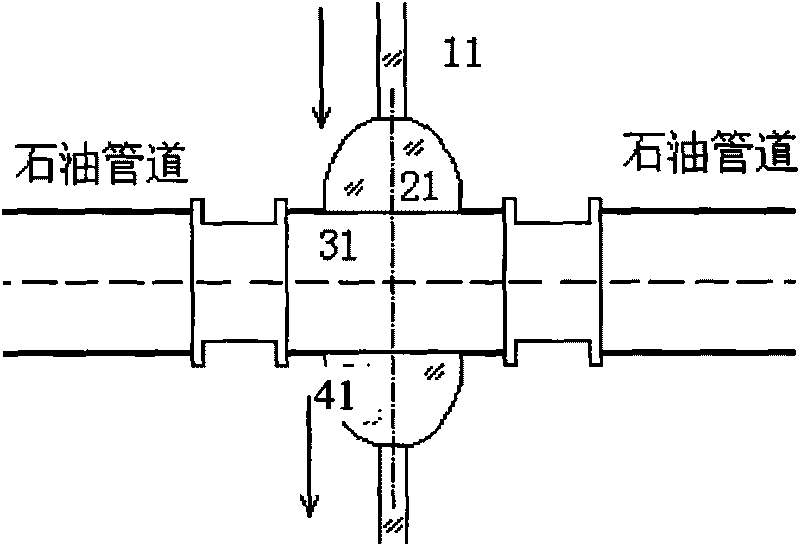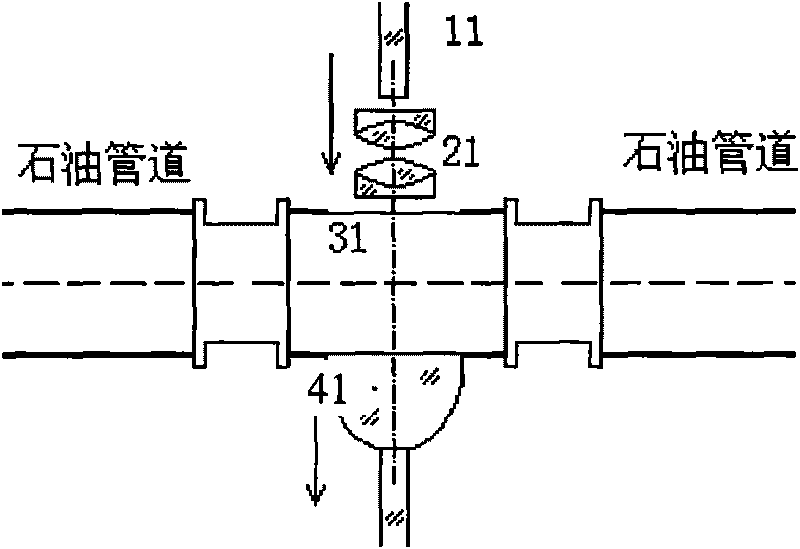Transmission spectra based method and device for detecting oil product interfaces in oil pipelines
An oil pipeline and transmission spectroscopy technology is applied in the field of detection of oil product interfaces in oil pipelines, which can solve the problems that oil products cannot be well classified and the refractive index cannot be distinguished, so as to improve the detection precision and accuracy, and judge the oil product interface accurately. , the effect of rich information
- Summary
- Abstract
- Description
- Claims
- Application Information
AI Technical Summary
Problems solved by technology
Method used
Image
Examples
Embodiment 1
[0029] The first metal fastener 31 and the second metal fastener 32 ensure that the geometric distance between the collimating light component and the light-transmitting surface of the light-condensing component is 80 mm, and the third metal fastener 33 ensures that the collimating light component and the light-condensing component pass through. The geometric distance of the light surface is 20 mm, and the fourth metal fastener 34 ensures that the geometric distance of the light-transmitting surface of the collimating light component and the light-condensing component is 4 mm. The metal fastener designed in this way can perform spectral measurement very well, so as to ensure the subsequent precise interface positioning.
[0030] Before the device goes online, build six models, collect 200 domestic finished gasolines of 90#, 93#, 97#, and 98# each, and obtain the spectra of these gasolines in the 700-1000nm band on the device. Using the method of discriminant cluster analysis, ...
Embodiment 2
[0041] Compared with Embodiment 1, the difference of this embodiment is that the six classification models are established in the 1000-2500nm band.
[0042] Before the device goes online, build six models, collect 200 domestic finished gasolines of 90#, 93#, 97#, and 98# each, and obtain the spectra of these gasolines in the 1000-2500nm band on the device. Using the method of discriminant cluster analysis, a gasoline classification model 1 is established. Using the artificial neural network classification method, the gasoline classification model 2 is established. Using the partial least bisecting algorithm of principal component analysis, the gasoline classification model 3 is established.
[0043] Then collect 150 domestic finished diesel oils of 5#, 0#, -10#, -20#, -35#, and -50#, and obtain the spectra of these diesel oils in the 1000-2500nm band on the device. Using the method of discriminant cluster analysis, the classification model 4 of diesel is established. Using ...
Embodiment 3
[0052] The difference between this embodiment and Embodiment 1 is that the six classification models are established in the 2500-5000nm band.
[0053] Before the device goes online, build six models, collect 200 domestic finished gasolines of 90#, 93#, 97#, and 98# each, and obtain the spectra of these gasolines in the 2500-5000nm band on the device. Using the method of discriminant cluster analysis, a gasoline classification model 1 is established. Using the artificial neural network classification method, the gasoline classification model 2 is established. Using the partial least bisecting algorithm of principal component analysis, the gasoline classification model 3 is established.
[0054] Then collect 150 domestic finished diesel oils of 5#, 0#, -10#, -20#, -35#, and -50#, and obtain the spectra of these diesel oils in the 2500-5000nm band on the device. Using the method of discriminant cluster analysis, the classification model 4 of diesel is established. Using the ar...
PUM
 Login to View More
Login to View More Abstract
Description
Claims
Application Information
 Login to View More
Login to View More - R&D
- Intellectual Property
- Life Sciences
- Materials
- Tech Scout
- Unparalleled Data Quality
- Higher Quality Content
- 60% Fewer Hallucinations
Browse by: Latest US Patents, China's latest patents, Technical Efficacy Thesaurus, Application Domain, Technology Topic, Popular Technical Reports.
© 2025 PatSnap. All rights reserved.Legal|Privacy policy|Modern Slavery Act Transparency Statement|Sitemap|About US| Contact US: help@patsnap.com



